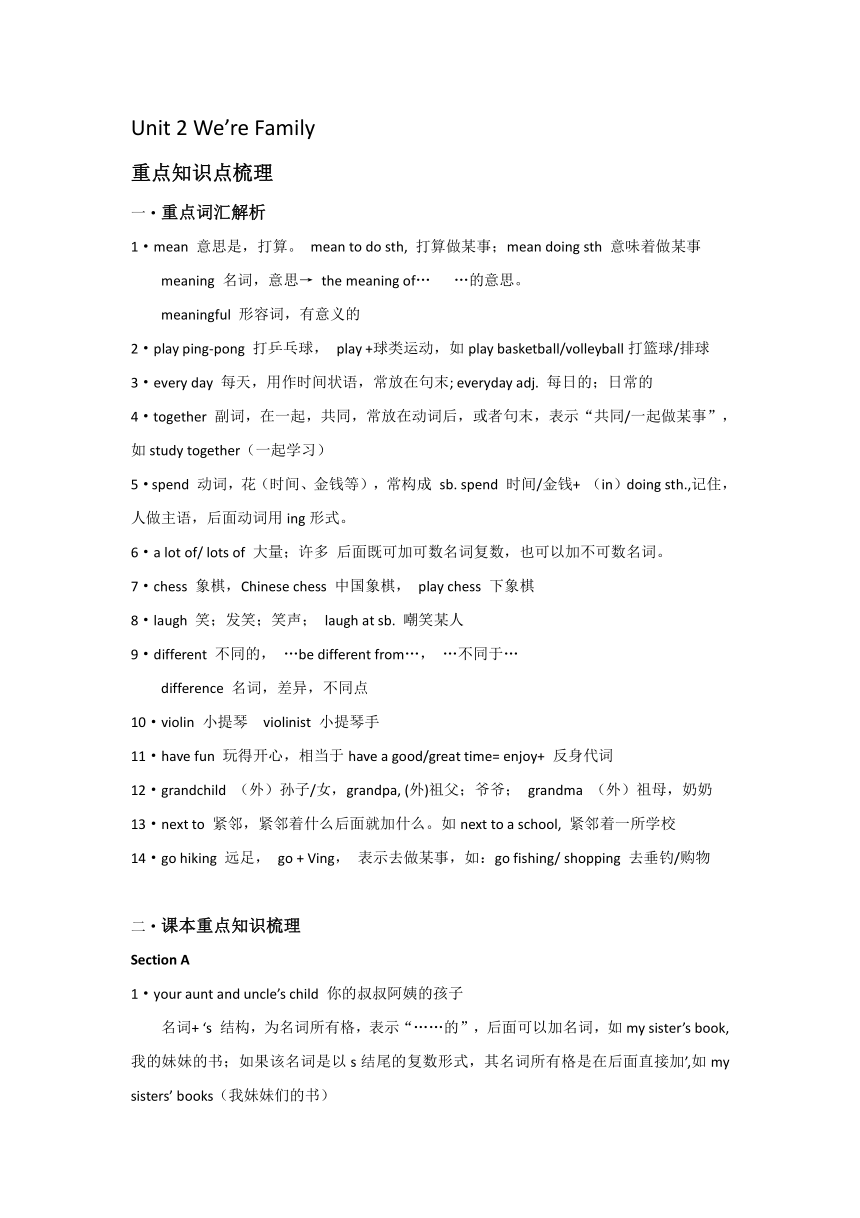 资源简介
资源简介
Unit 2 We’re Family
重点知识点梳理
一·重点词汇解析
1·mean 意思是,打算。 mean to do sth, 打算做某事;mean doing sth 意味着做某事
meaning 名词,意思→ the meaning of… …的意思。
meaningful 形容词,有意义的
2·play ping-pong 打乒乓球, play +球类运动,如play basketball/volleyball打篮球/排球
3·every day 每天,用作时间状语,常放在句末; everyday adj. 每日的;日常的
4·together 副词,在一起,共同,常放在动词后,或者句末,表示“共同/一起做某事”,如study together(一起学习)
5·spend 动词,花(时间、金钱等),常构成 sb. spend 时间/金钱+ (in)doing sth.,记住,人做主语,后面动词用ing形式。
6·a lot of/ lots of 大量;许多 后面既可加可数名词复数,也可以加不可数名词。
7·chess 象棋,Chinese chess 中国象棋, play chess 下象棋
8·laugh 笑;发笑;笑声; laugh at sb. 嘲笑某人
9·different 不同的, …be different from…, …不同于…
difference 名词,差异,不同点
10·violin 小提琴 violinist 小提琴手
11·have fun 玩得开心,相当于have a good/great time= enjoy+ 反身代词
12·grandchild (外)孙子/女,grandpa, (外)祖父;爷爷; grandma (外)祖母,奶奶
13·next to 紧邻,紧邻着什么后面就加什么。如next to a school, 紧邻着一所学校
14·go hiking 远足, go + Ving, 表示去做某事,如:go fishing/ shopping 去垂钓/购物
二·课本重点知识梳理
Section A
1·your aunt and uncle’s child 你的叔叔阿姨的孩子
名词+ ‘s 结构,为名词所有格,表示“……的”,后面可以加名词,如my sister’s book,我的妹妹的书;如果该名词是以s结尾的复数形式,其名词所有格是在后面直接加’,如my sisters’ books(我妹妹们的书)
注意:当and连接两个名词时,其所有格形式有两种,形式不同,意义也不同,具体如下:
aunt and uncle’s child , 叔叔和阿姨的孩子(一个’s是共有的)
aunt’s and uncle’s children, 阿姨的孩子和叔叔的孩子(两个’s是各自的)
2· Oh, these ping-pong bats are nice. Whose are they 这些乒乓球拍很不错,他们是谁的?
whose fishing rods are those 那些是谁的钓竿?
whose为特殊疑问词,意为“谁的”,当知道询问对象是,可以直接放在句首进行提问;若不知道询问对象时,则需要用whose +名词进行提问。
Eg:There is a ping-pong bat, whose is it 这儿有个乒乓球拍,它是谁的?
Look, whose book is this 看,这是谁的书?
3·He spends a lot of/ lots of time fishing. 他花很多时间钓鱼。
常考句型: sb. spend 时间(in)doing sth.
= it takes sb 时间 to do sth.
Section B
1·He often makes us laugh. 他总是让我们笑。
句中make为使役动词,其常考结构为make sb. do sth, 意为“让某人做某事”注意后面的do指代的是动词原形。
Eg: Mum often makes me do housework. 妈妈经常让我做家务。
2· Here is a photo of us. 这有一张我们的照片。
a photo of…,一张…的照片,为of 所有格,of表示所属关系,意为“…的”,翻译的时候,需要倒过来翻译,如a map of the world 世界地图,a photo of my family 家庭照。
3· I’m the one with the pink hat.我是这个带着粉红帽子的(女孩)
the one 在句中指代the girl; with 表示“戴着,附带,有”,with the pink hat短语做后置定语(放在被修饰词后的修饰成分),对the one(girl)进行修饰,意为“戴着粉红色帽子的”。类似的用法还有 a boy with glasses(一个戴着眼镜的男生),a classroom with a computer(一间有电脑的教室)等。
4·This is my dad, Fred, on the left. 这是我的爸爸,佛雷德,在左边。
On the left, 表示“在左边,在左边的”,还有“在右边”,on the right。当需要表达“在某人的左边或者右边”时,用 on + 形容词性物主代词+ left/ right.
5·She always reads me a story at night.她总是在九点钟给我讲故事。
read sb a story, 意为“给某人读故事”;
at nine, 在九点钟,at是时间介词,at +基数词,表示在几点钟,如:at 7:45.
6·But I think they say the same thing to all of us!但是我认为他们给我们所有人说了同样的话。
I think+ 陈述句(完整的句子),意为“我认为…”,后面的句子为宾语从句,应当用陈述语序,即:主语+谓语+其他,如:
I think my English teacher is good. 我认为我的英语老师很棒。句中My English teacher is good, 本身就是一个完整的陈述句,放在think 后面,作宾语,固为宾语从句。
Lily thinks she is her grandparents’ favorite grandchild. Lily 认为她是她爷爷奶奶最喜欢的孙女。句中she is she grandparents’ favorite grandchild 是一个完整的陈述句,放在think后面,作宾语,为宾语从句。
7·Take turns to describe the photo in 1b. 轮流表述1b中的图片。
turn 作名词时,表示“轮次,轮流”, take turns to do sth. “轮流做某事”
8· This is my family photo. 这是我的全家照
my family photo= a photo of my family, 全家福(照)
展开更多......
收起↑
 资源预览
资源预览

 资源预览
资源预览
